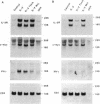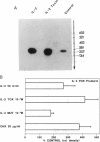Abstract
The interleukin 2-diphtheria toxin-related fusion protein (IL-2-toxin) rapidly inhibits protein synthesis in IL-2 receptor (IL-2R)-bearing phytohemagglutinin-activated T cells but transiently stimulates DNA synthesis. At 7 hr after interaction with IL-2R+ phytohemagglutinin-activated T cells, IL-2-toxin-treated cells bear augmented steady-state levels of c-myc, interferon gamma, and IL-2R mRNA; these effects are indistinguishable from those produced by recombinant IL-2. Amplification of IL-2 sequences by the polymerase chain reaction reveals an increased level of IL-2 mRNA in cell cultures treated with recombinant IL-2, IL-2-toxin, and cycloheximide. These results suggest that IL-2-toxin can affect de novo IL-2 gene transcription/mRNA stabilization through independent mechanisms exerted by both the IL-2R binding domain and ADP-ribosyltransferase activity of the fusion protein. After 20 hr of culture, IL-2R mRNA was markedly decreased in both IL-2-toxin- and cycloheximide-treated phytohemagglutinin-activated T cells. Although interaction of IL-2-toxin with IL-2R+ T cells initially mimics the stimulatory effects of IL-2 upon c-myc, interferon gamma, IL-2R, and IL-2 gene expression, the consequences of inhibition of protein synthesis mediated by the ADP-ribosyltransferase activity of the toxin dominate after 7 hr and are indistinguishable from those effects mediated by cycloheximide.
Full text
PDF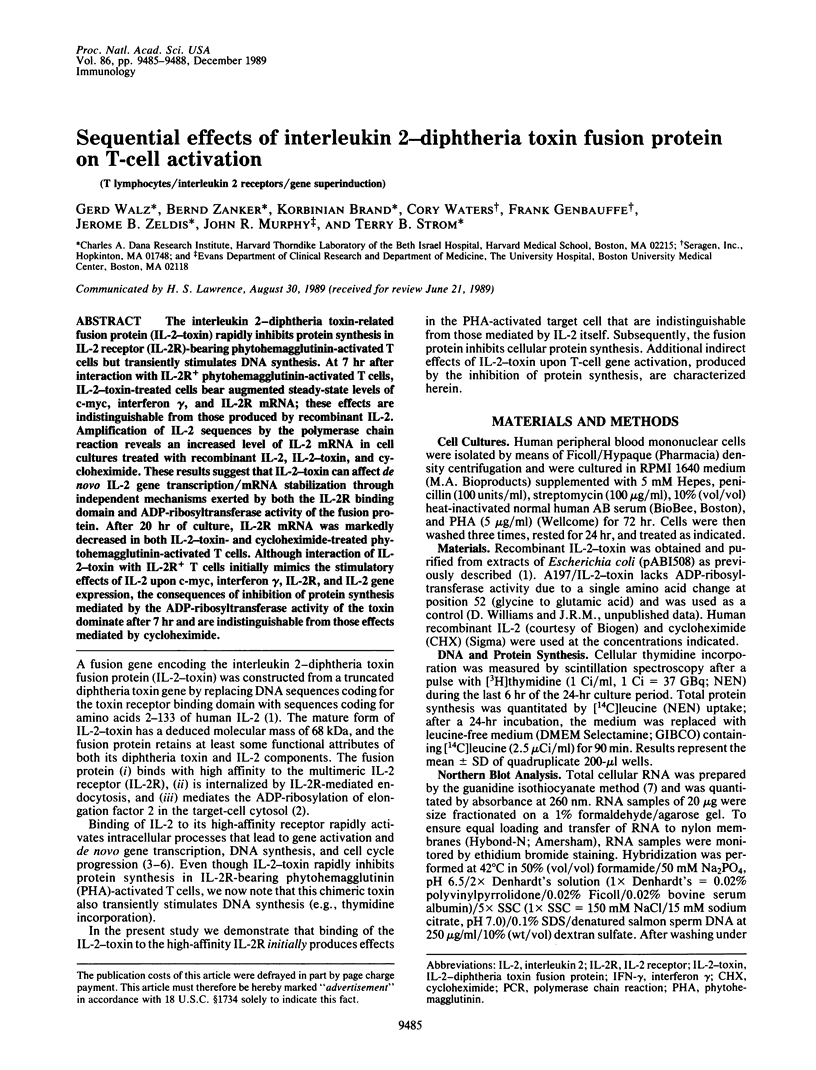
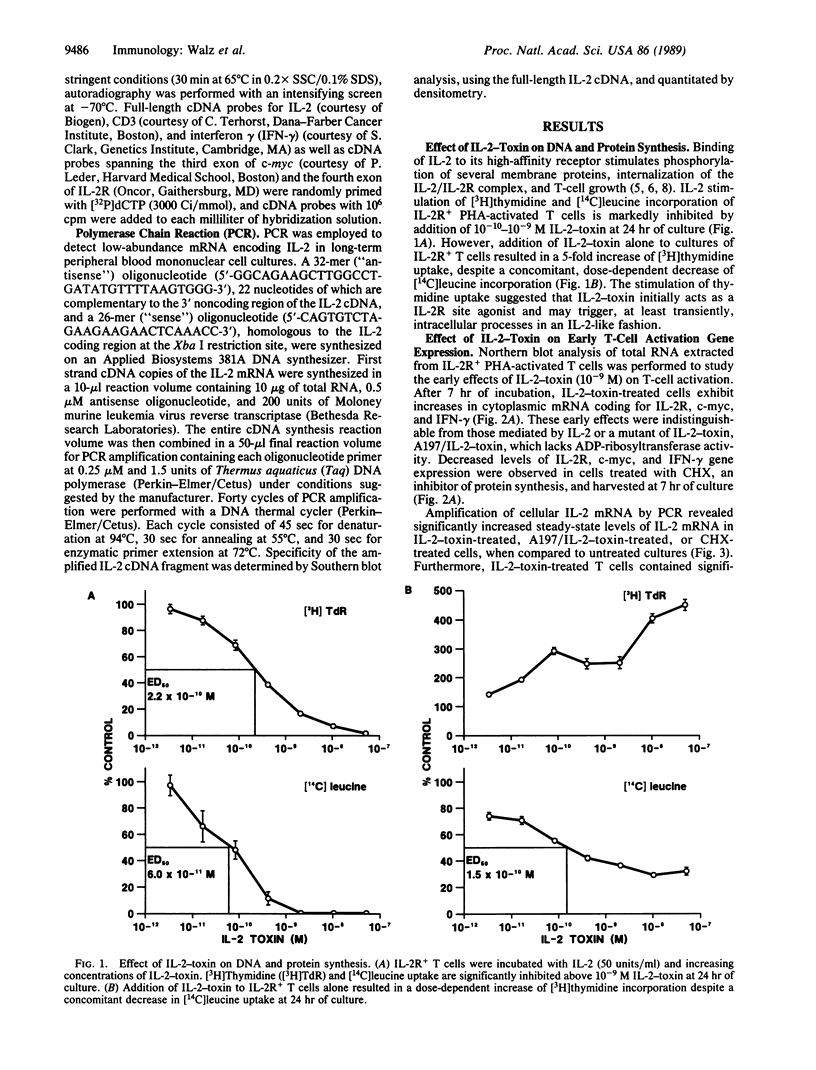
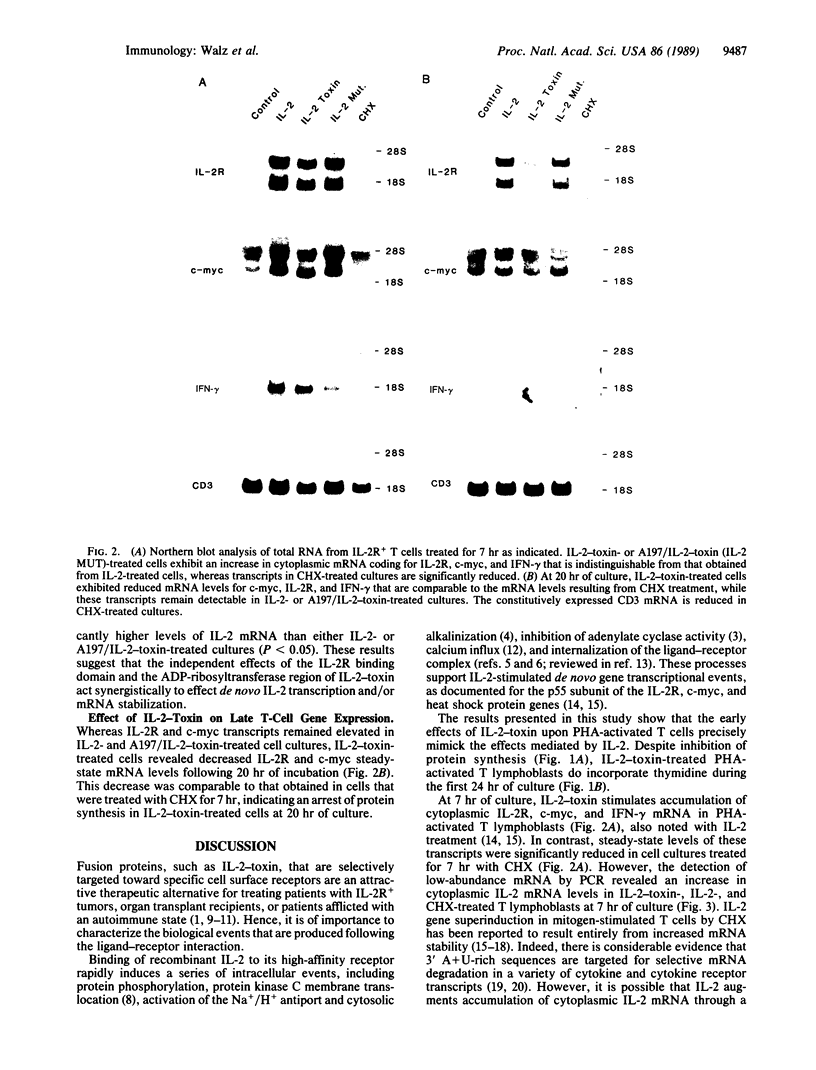
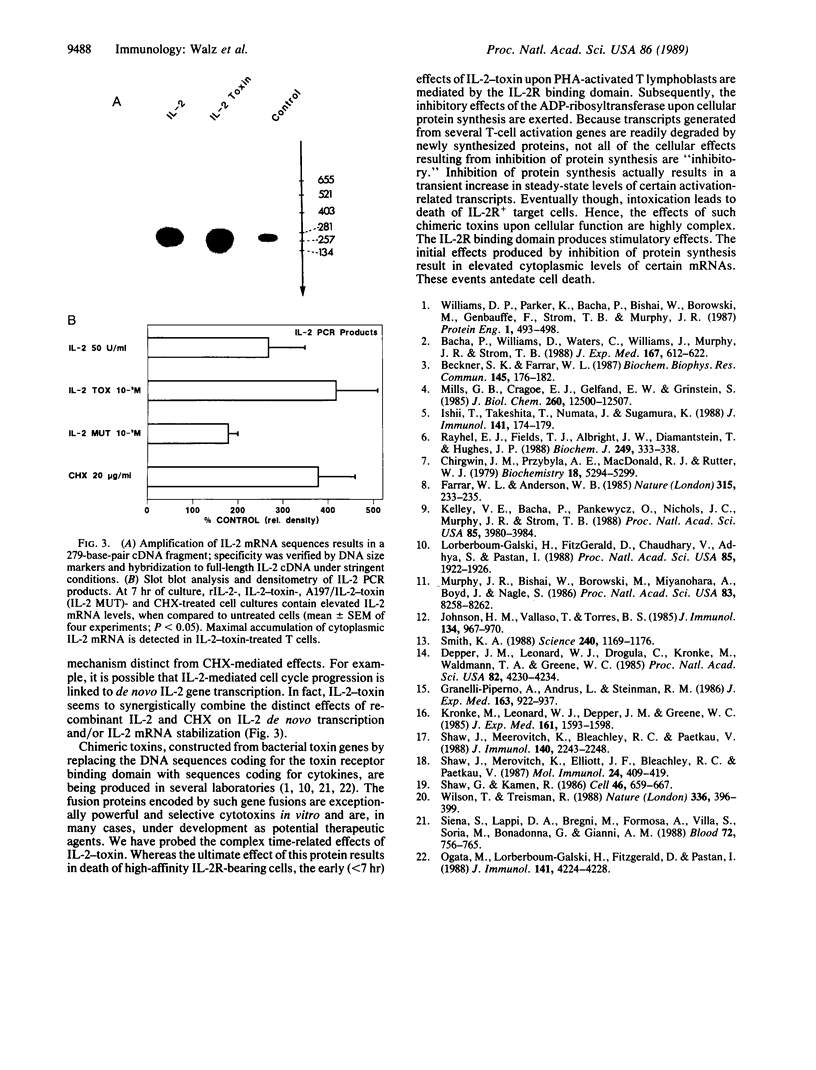
Images in this article
Selected References
These references are in PubMed. This may not be the complete list of references from this article.
- Bacha P., Williams D. P., Waters C., Williams J. M., Murphy J. R., Strom T. B. Interleukin 2 receptor-targeted cytotoxicity. Interleukin 2 receptor-mediated action of a diphtheria toxin-related interleukin 2 fusion protein. J Exp Med. 1988 Feb 1;167(2):612–622. doi: 10.1084/jem.167.2.612. [DOI] [PMC free article] [PubMed] [Google Scholar]
- Beckner S. K., Farrar W. L. Inhibition of adenylate cyclase by IL 2 in human T lymphocytes is mediated by protein kinase C. Biochem Biophys Res Commun. 1987 May 29;145(1):176–182. doi: 10.1016/0006-291x(87)91303-9. [DOI] [PubMed] [Google Scholar]
- Chirgwin J. M., Przybyla A. E., MacDonald R. J., Rutter W. J. Isolation of biologically active ribonucleic acid from sources enriched in ribonuclease. Biochemistry. 1979 Nov 27;18(24):5294–5299. doi: 10.1021/bi00591a005. [DOI] [PubMed] [Google Scholar]
- Depper J. M., Leonard W. J., Drogula C., Krönke M., Waldmann T. A., Greene W. C. Interleukin 2 (IL-2) augments transcription of the IL-2 receptor gene. Proc Natl Acad Sci U S A. 1985 Jun;82(12):4230–4234. doi: 10.1073/pnas.82.12.4230. [DOI] [PMC free article] [PubMed] [Google Scholar]
- Farrar W. L., Anderson W. B. Interleukin-2 stimulates association of protein kinase C with plasma membrane. Nature. 1985 May 16;315(6016):233–235. doi: 10.1038/315233a0. [DOI] [PubMed] [Google Scholar]
- Granelli-Piperno A., Andrus L., Steinman R. M. Lymphokine and nonlymphokine mRNA levels in stimulated human T cells. Kinetics, mitogen requirements, and effects of cyclosporin A. J Exp Med. 1986 Apr 1;163(4):922–937. doi: 10.1084/jem.163.4.922. [DOI] [PMC free article] [PubMed] [Google Scholar]
- Ishii T., Takeshita T., Numata N., Sugamura K. Protein phosphorylation mediated by IL-2/IL-2 receptor beta-chain interaction. J Immunol. 1988 Jul 1;141(1):174–179. [PubMed] [Google Scholar]
- Johnson H. M., Vassallo T., Torres B. A. Interleukin 2-mediated events in gamma-interferon production are calcium dependent at more than one site. J Immunol. 1985 Feb;134(2):967–970. [PubMed] [Google Scholar]
- Kelley V. E., Bacha P., Pankewycz O., Nichols J. C., Murphy J. R., Strom T. B. Interleukin 2-diphtheria toxin fusion protein can abolish cell-mediated immunity in vivo. Proc Natl Acad Sci U S A. 1988 Jun;85(11):3980–3984. doi: 10.1073/pnas.85.11.3980. [DOI] [PMC free article] [PubMed] [Google Scholar]
- Krönke M., Leonard W. J., Depper J. M., Greene W. C. Sequential expression of genes involved in human T lymphocyte growth and differentiation. J Exp Med. 1985 Jun 1;161(6):1593–1598. doi: 10.1084/jem.161.6.1593. [DOI] [PMC free article] [PubMed] [Google Scholar]
- Lorberboum-Galski H., FitzGerald D., Chaudhary V., Adhya S., Pastan I. Cytotoxic activity of an interleukin 2-Pseudomonas exotoxin chimeric protein produced in Escherichia coli. Proc Natl Acad Sci U S A. 1988 Mar;85(6):1922–1926. doi: 10.1073/pnas.85.6.1922. [DOI] [PMC free article] [PubMed] [Google Scholar]
- Mills G. B., Cragoe E. J., Jr, Gelfand E. W., Grinstein S. Interleukin 2 induces a rapid increase in intracellular pH through activation of a Na+/H+ antiport. Cytoplasmic alkalinization is not required for lymphocyte proliferation. J Biol Chem. 1985 Oct 15;260(23):12500–12507. [PubMed] [Google Scholar]
- Murphy J. R., Bishai W., Borowski M., Miyanohara A., Boyd J., Nagle S. Genetic construction, expression, and melanoma-selective cytotoxicity of a diphtheria toxin-related alpha-melanocyte-stimulating hormone fusion protein. Proc Natl Acad Sci U S A. 1986 Nov;83(21):8258–8262. doi: 10.1073/pnas.83.21.8258. [DOI] [PMC free article] [PubMed] [Google Scholar]
- Ogata M., Lorberboum-Galski H., FitzGerald D., Pastan I. IL-2-PE40 is cytotoxic for activated T lymphocytes expressing IL-2 receptors. J Immunol. 1988 Dec 15;141(12):4224–4228. [PubMed] [Google Scholar]
- Rayhel E. J., Fields T. J., Albright J. W., Diamantstein T., Hughes J. P. Interleukin 2 and a lactogen regulate proliferation and protein phosphorylation in Nb2 cells. Biochem J. 1988 Jan 15;249(2):333–338. doi: 10.1042/bj2490333. [DOI] [PMC free article] [PubMed] [Google Scholar]
- Shaw G., Kamen R. A conserved AU sequence from the 3' untranslated region of GM-CSF mRNA mediates selective mRNA degradation. Cell. 1986 Aug 29;46(5):659–667. doi: 10.1016/0092-8674(86)90341-7. [DOI] [PubMed] [Google Scholar]
- Shaw J., Meerovitch K., Bleackley R. C., Paetkau V. Mechanisms regulating the level of IL-2 mRNA in T lymphocytes. J Immunol. 1988 Apr 1;140(7):2243–2248. [PubMed] [Google Scholar]
- Shaw J., Meerovitch K., Elliott J. F., Bleackley R. C., Paetkau V. Induction, suppression and superinduction of lymphokine mRNA in T lymphocytes. Mol Immunol. 1987 May;24(5):409–419. doi: 10.1016/0161-5890(87)90014-9. [DOI] [PubMed] [Google Scholar]
- Siena S., Lappi D. A., Bregni M., Formosa A., Villa S., Soria M., Bonadonna G., Gianni A. M. Synthesis and characterization of an antihuman T-lymphocyte saporin immunotoxin (OKT1-SAP) with in vivo stability into nonhuman primates. Blood. 1988 Aug;72(2):756–765. [PubMed] [Google Scholar]
- Smith K. A. Interleukin-2: inception, impact, and implications. Science. 1988 May 27;240(4856):1169–1176. doi: 10.1126/science.3131876. [DOI] [PubMed] [Google Scholar]
- Williams D. P., Parker K., Bacha P., Bishai W., Borowski M., Genbauffe F., Strom T. B., Murphy J. R. Diphtheria toxin receptor binding domain substitution with interleukin-2: genetic construction and properties of a diphtheria toxin-related interleukin-2 fusion protein. Protein Eng. 1987 Dec;1(6):493–498. doi: 10.1093/protein/1.6.493. [DOI] [PubMed] [Google Scholar]
- Wilson T., Treisman R. Removal of poly(A) and consequent degradation of c-fos mRNA facilitated by 3' AU-rich sequences. Nature. 1988 Nov 24;336(6197):396–399. doi: 10.1038/336396a0. [DOI] [PubMed] [Google Scholar]



